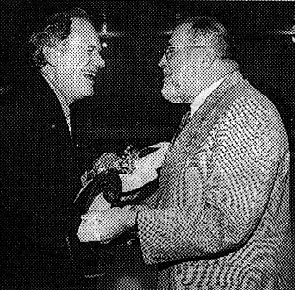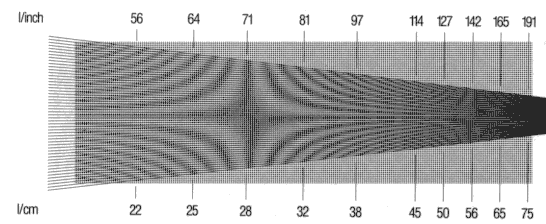Moiré
![]() Moire (spelled: mwareh), moire
pattern, moire fringes
Moire (spelled: mwareh), moire
pattern, moire fringes
![]() Moiré, moiré
muster
Moiré, moiré
muster
![]() Moiré
Moiré
The word moiré has its root in the special shining appearance of the mohair wool (exact etymology of the word varies according sources...).
Moiré pattern were seen wherever a repetitive structure is overlaid with another structure and the line elements are nearly superimposed.
Everyday examples include the patterns produced by overlapping window insect screens or by the folds in a nylon curtain. A very good example is created by the railing of a bridge seen from a distance. Due to the perspective the rail farer away gets the smaller spacing of the rods. This difference to the spacing of the nearer railing creates a regular pattern. If you move, this pattern moves much faster across the railing (superimposing two similar structures, which differ only lightly in scale, creates a similar difference pattern of large scale).
 |
 |
The following image from a newspaper demonstrates the moiré effect on the cloth of the right person. The image obviously was re-scanned from an already scanned image (a third scanning for this GIF image just enhanced the effect).

The moiré effect has many applications to mathematics and physics including theoretical physics. A common application is measurement of small differences. The smaller the difference in grid width, the larger the virtual grid presented by the moiré effect. In the printing trade the effect is used for screen determinators (screen finders):
![[To top/bottom of page]](../../z_designs/nav-dnup.gif) More moiré
patterns
More moiré
patterns
Copying a figure with regular patterns upon itself on a slightly different position creates the various moiré patterns. The moiré pattern often can be seen even better with blurred vision (e.g. take your glasses off).
| Figure with regular pattern | Two of the same figures are super-imposed on a slightly different position. |
 |
 |
 |

|
 |
 |
 |
 |
![[To top/bottom of page]](../../z_designs/nav-dnup.gif) Sources
Sources
Optical Design in Motion, booklet and experimentation materials Edmund Scientific
Co., Barrington, New Jersey
Also available from Spektrum der Wissenschaft, Deutschland
![]()
Scan Graphics Designometer. Scangraphic Dr. Böger GmbH, D-2000 Wedel/Hamburg.
PostScript file to generate some of the patterns from above on your printer (by Klaus Daube).
PostScript file by I Amidror, EPFL creating 3 nice patterns.
![[To top/bottom of page]](../../z_designs/nav-dnup.gif) Further links
Further links
- Modelization
of the Moiré Phenomenon
Based on the Fourier theory, a mathematical modelization of the moiré phenomenon has been developed that can be used for both analysis and synthesis of moiré effects. This approach provides a full qualitative and quantitative understanding of the various phenomena which occur in the superposition of periodic layers (line gratings, dot screens, etc.), both in the image and in the spectral domains. - The
Theory of the Moiré Phenomenon
This book provides a full, general purpose and application independent exposition of the moiré phenomenon. - Moiree
demonstration kit
The reason for this site is that moiré effects are always best appreciated by a hands-on experience. Static figures printed in a book can never offer the same visual insight into the moiré phenomenon as an actual manipulation of the individual layers in a superposition. - New
colour halftoning techniques
Colour Reproduction: New colour halftoning techniques are being developed. Models for the prediction of printed colours are being created, which aim at replacing standard calibration packages [Emmel96]. Research proceeds in respect to the analysis of the moiré phenomenon [Amidror96]. - Enhanced
moiré resolution
If the three-dimensional surface shape of an object needs to be analyzed, one of the common means for doing so is to use Moire, or the interference pattern that results when two similar patterns of lines cross each other. If, for example, the cone was analyzed with respect to a flat plate, the interference pattern that would appear would contain equal-depth contours, much like what one. - Moiré test
films
If you have a technical or theoretical interest in PostScript halftoning, the following PostScript programs may be useful to you. Written for halftone screen-set development, they were released by Adobe concurrently with PostScript Screening: Adobe Accurate Screens. To get the most from these programs, you should have some experience programming PostScript code. - Wind
tunnel photographs
A photograph shows a typical drift shape deposited around a right circular cylinder. Below is the moire photograph of the cylinder with its accompanying drift. The black contour lines indicate an incremental change in elevation of the topography similar to a topographical map.
